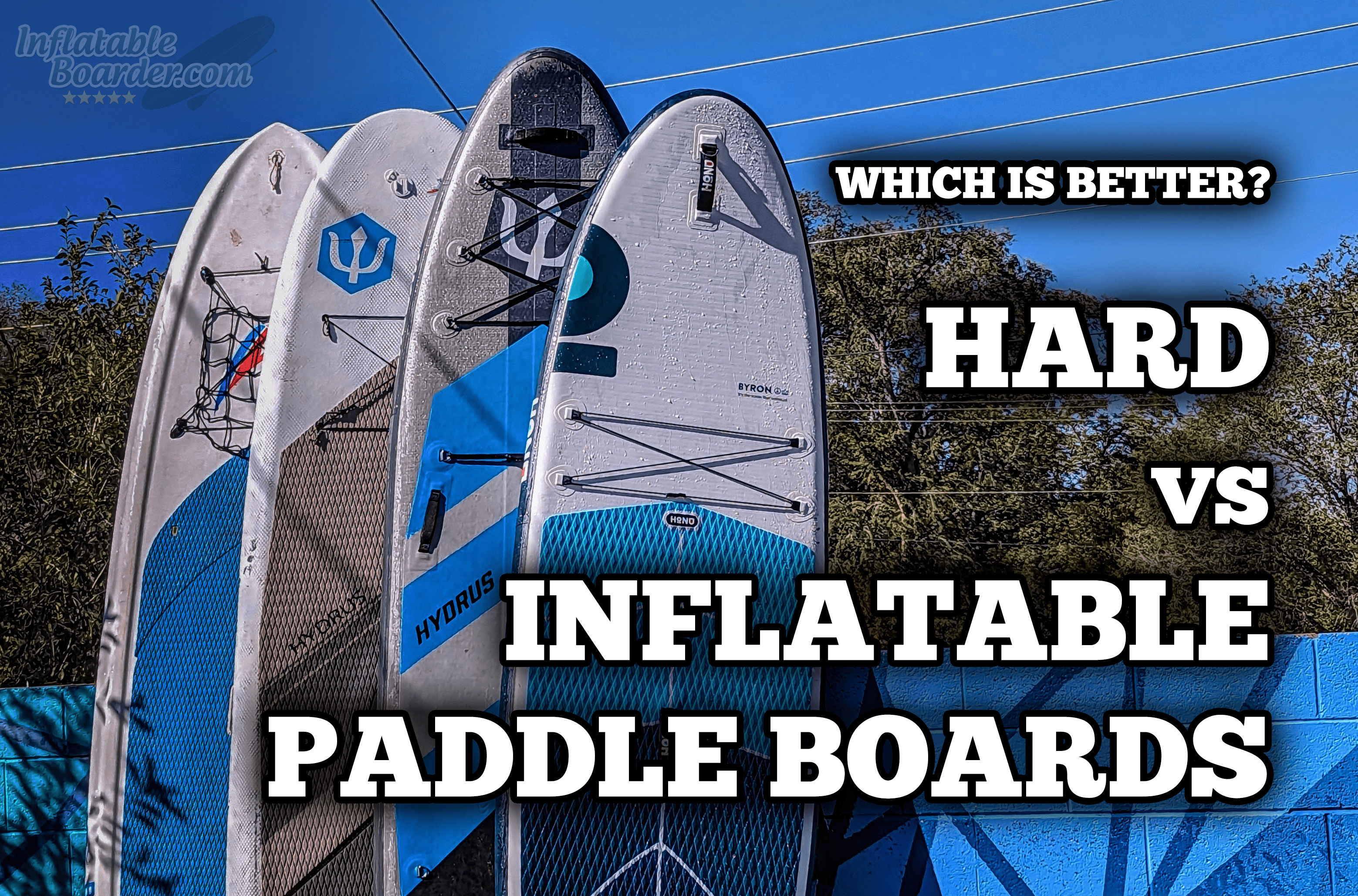
There isn’t another topic out there as hotly, and frequently, debated in paddle boarding as this. Which one is better – A hard SUP or an inflatable SUP?
There is only one definite answer to this question: It depends! 🤣
In all seriousness, though, whether or not an inflatable SUP is better than a hard SUP is really going to come down to the board’s use and the user. To help you determine which is better for you let’s break down some of the key differences and similarities.
What’s What
Inflatable SUPs
Inflatable paddle boards (iSUPs) are made with three basic parts. The first part is what is known as a “Double-Wall Fabric,” or DWF, core. This is two layers of polyester fabric that are connected together with thousands of Drop Stitched yarns. These yarns set the correct spacing to give an iSUP its proper thickness and flat shape. They also help with the board’s rigidity. Next is the shell of the board. This can be made in a number of different ways and is usually referred to by the number of individual layers of PVC used to create the shell. Third component is the rail that wraps all the way around the board joining the top and bottom together. Inflatable SUPs use air pressure (and their construction) to take on their shape and provide enough rigidity to stand and paddle. There is a ton of variation in each of these components. Read our blog post about iSUP Construction 101 for more information.
Rigid / Hard SUPs
Hard, or Rigid, SUPs are made with two basic components. First is the foam blank. This is a solid piece of foam that is shaped either by hand or by CNC machine to the specified size and shape. The shell of the board is made with a composite of a fabric material and a resin (usually polyester or epoxy, sometimes a type of plastic). Common materials are fiberglass, carbon fiber, kevlar, and sometimes wood veneer layers. The exact number of layers, types of fabrics, how and where they are placed, etc. is different from board to board. These boards are often referred to by one or more of their materials like “epoxy SUP,” “fiberglass SUP,” or sometimes “composite SUP”. There are also other types of hard boards made with wood (usually covered in fiberglass) or plastic and generally without a foam center. For the most part when we (or anyone) refer to hard boards, they are referring to foam-core/composite boards rather than hollow wood/plastic options.
Size and Use
Size
Both inflatable SUPs and hard SUPs come in a huge variety of sizes and shapes. You can get either construction in sizes from 7’ long up to over 17’ long. You can get both iSUPs and hard SUPs in widths from 24-36” wide. There are some hard boards that are available in even longer sizes (up to about 21’ is the longest I’ve seen), and there are some inflatables available in ultra-large sizes for multiple people (up to 15’ x 54”).
Use
With those sizes and shapes you can get boards shaped for any SUP activity you can think of. All-around paddling, touring, yoga, racing, fishing, whitewater, surfing, and even foil boards are available in both inflatable and hard constructions.
You can find both inflatable and hard paddle boards in just about any size and shape you want.
Winner: Tie
Transportation, Storage, and Availability
These characteristics are sometimes overshadowed in the inflatable vs rigid SUP debate, but they are crucially important for just about everyone.
Transportation and Storage
Being able to actually transport your paddle board and store it in an appropriate and safe location are just as important as its performance. If you can’t get it to the water (or if it becomes damaged or stolen) then it doesn’t matter if it’s the best performing board in the world.
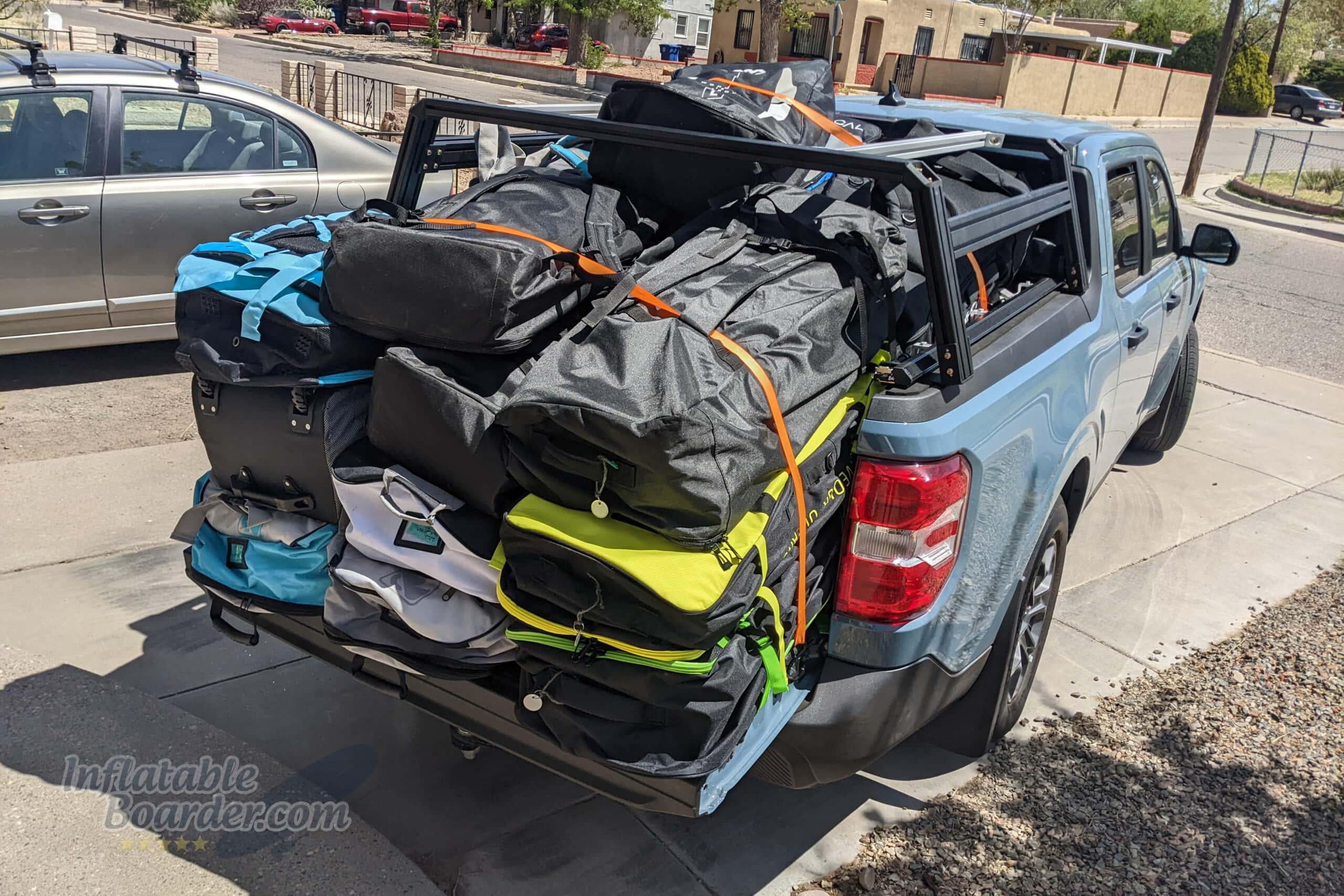
Here inflatable SUPs have an obvious advantage. When not in use, iSUPs can be deflated, rolled up, and kept in a bag that’s about 120-150 L in volume, and takes up as little as 1.5 square feet of floor space. Roughly the same amount of space as a full-size upright vacuum cleaner. Newer compact iSUPs can take up even less room – as little as 40L / less than 1 square foot of floor space.
This not only makes iSUPs easier to store at home, but it makes them much easier to get from point A to point B. You can easily fit an iSUP in any standard vehicle, and many of them are small enough to fit into sports cars, smart cars, and other smaller vehicles. Some can even fit into bicycle and motorcycle panniers (and most can be worn on your back if not)! Public transportation, air travel, and more are all easily possible with an iSUP, but extremely hard with a hard SUP.
On the down side, inflatable SUPs do require you to inflate and deflate the board between uses to take advantage of these features. This takes about 10 minutes on average to get the board ready-to-ride.
Storing a hard paddle board requires plenty of space for the board itself, but also a way to get the board into that space. Even if you have wall hangers ready and space cleared, if you have to take your board up three flights of stairs to get into your apartment, you may not be able to pivot hard enough to make it fit no matter what.
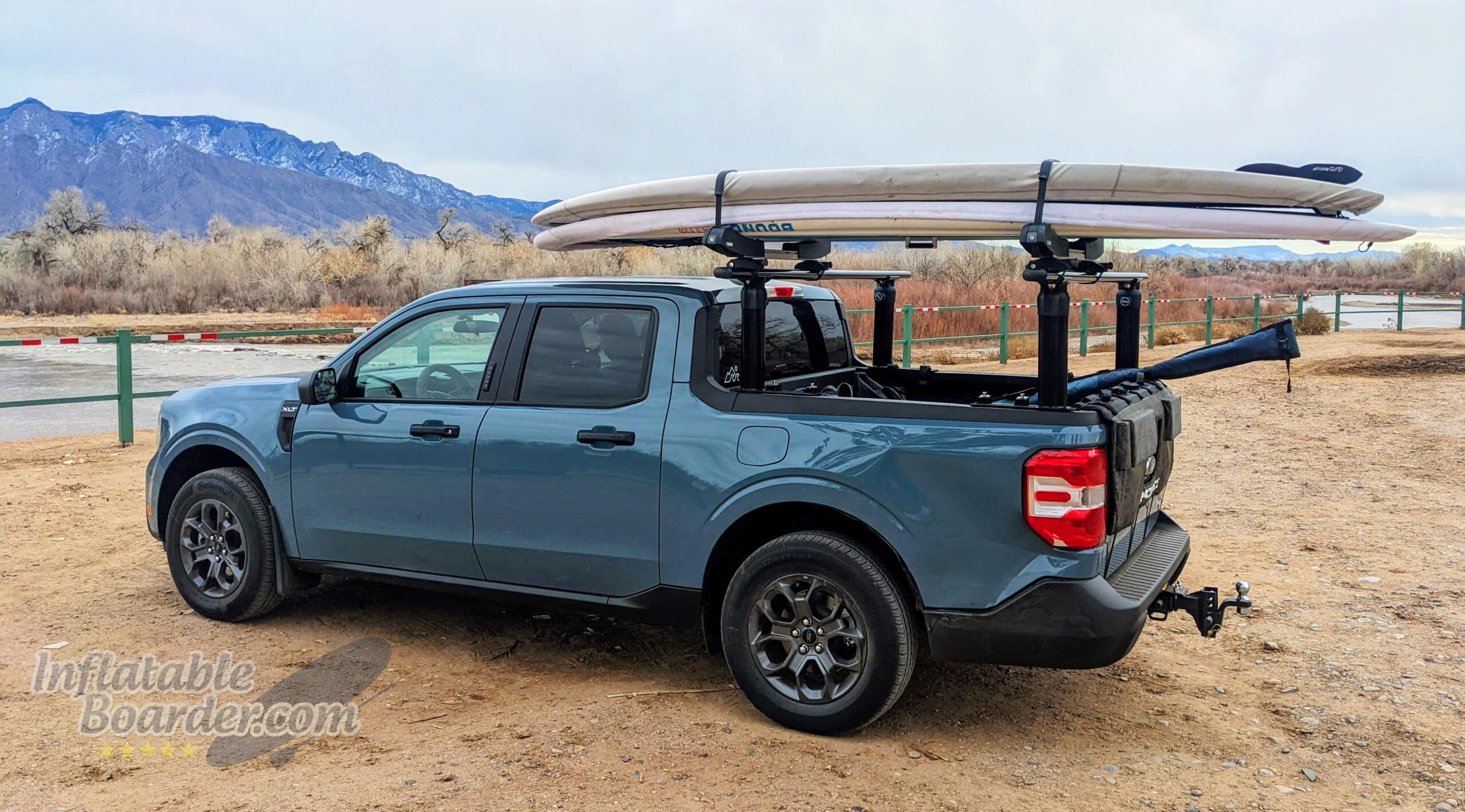
Hard SUPs require specialized equipment to carry safely on top of your vehicle, can’t be taken on public transportation, and can be very difficult or impossible to fly with (necessitating freight shipping if you really want to move it long distance). On the up-side, hard SUPs require very little time and effort to set up between storage and ready-to-ride.
Availability
In addition to your storage and transportation requirements, just getting a hard board may be difficult or expensive to do if you don’t have a nearby retail store that carries exactly what you are looking for. While inflatable SUPs can be easily purchased online and shipped directly to your doorstep (usually with no additional shipping cost), taking delivery of a hard paddle board is much more time consuming and expensive. You’ll either need to pick up the board in person from the seller, or pay to have it “Less-Than-Truckload” freight-shipped to your closest shipping node. Then you’ll have a specific amount of time (and window during the day) to arrive, inspect the packaging and board for damage, and then load the board up on your vehicle to take home. All of this can run in excess of $200 on top of your purchase price.
If you need to return your board for any reason, you’ll have to reverse the process. While most iSUP companies do not offer free return shipping, the cost of packing your board back up and taking it to your local FedEx or UPS store for delivery will usually be between $40-$75, vs another $200+ for a hard board (if returnable at all).
Winner: Inflatable SUPs
Durability and Warranty
It’s a common misconception that inflatable paddle boards are not durable, puncture easily, or are the equivalent of a “pool toy.” Usually those who live by these ideas also tend to think that rigid SUPs are super durable and can take lots of abuse. However, neither is true.
Dings and Dents
Inflatable paddle boards are actually extremely durable. The PVC materials used in creating the board are relatively thick compared to fiberglass or carbon fiber hard boards (which aids in their abrasion and cut resistance), and most importantly they are elastic. When an inflatable board encounters a hard object, the air-filled chamber and flexible PVC material is able to elastically deform around the object, and then reform to its appropriate shape after the impact.
Hard boards are inelastic. When a hard board impacts a solid object the composite material has very little flex, and if pressed will crack. Additionally, when this happens (and even if it doesn’t fully crack the composite material) the inelastic foam at the center of these boards can become compressed and does not reform after impact. A simple impact can result in a crack in your board, a dent (“ding”), or both. If the foam compressed but the composite material didn’t break, when the composite shell flattens back out, it can rip away and delaminate from the foam center leaving an air bubble. That air bubble can then grow/shrink depending on temperatures and further impacts and lead to board-destroying delaminations.
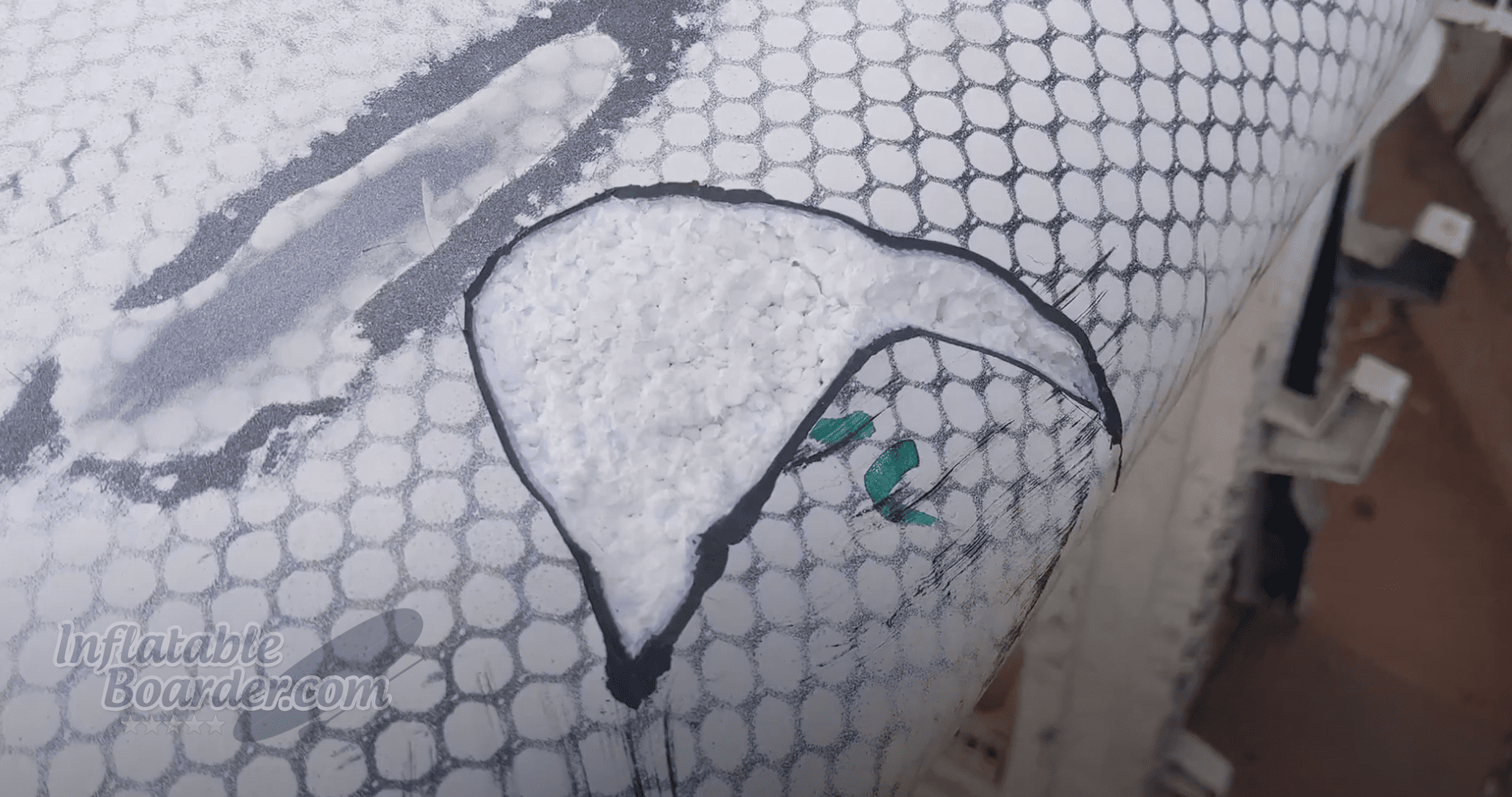
It doesn’t even take big impacts to create big-issue problems. “Pressure Dings” are dents put into a board just from the pressure of your feet on the deck of the board compressing the foam under the standing areas. Improper transportation and over-tightening of straps on your board can also cause dings and cracks.
Punctures from environmental hazards are a larger possibility on an inflatable than a hard board, but not by much. The largest factor here will be where you are using your board. Oyster beds and areas with lots of man-made objects/debris are big culprits, but the biggest by far is hazards off the water. Accidentally setting your board on broken glass, screws, or other sharp objects can lead to a puncture, as can bumping your board into sharp objects (metal signs, fences, trailer corners, etc.). However once on water that is more than a few inches deep those environmental concerns drop precipitously. If you do get a puncture in your iSUP, the repair process is very easy and requires minimal time and effort.
Between their inability to dent/ding and their abrasion and puncture-resistant materials, it makes perfect sense why inflatable SUPs are the preferred construction for those paddlers who go extremely hard on their boards – whitewater SUP. In Whitewater SUP you are constantly scraping, hitting, bouncing off rocks and logs, dropping over waves, and generally abusing your paddle board. While there are some hard SUPs made for whitewater, they don’t hold a candle to iSUPs when it comes to overall durability. My own personal hard whitewater SUP has been repaired about a half dozen times for everything from dings to tearing out a baseball-size chunk from the side (see image above), to having a near total-delamination of the deck. My inflatable whitewater SUPs have a few cosmetic scratches at worst.
Heat and pressure can be a factor for both inflatable and hard paddle boards. As temperatures rise some lower-quality adhesives used in lower-quality iSUPs can soften and cause failures at the seams of the board. In hard boards, failure to open, or maintain, a breather valve on your board can likewise lead to increased internal pressure and delamination between the foam center and composite shell of the board.
Warranty
Manufacturers offer different types and lengths of warranties for their products. One thing that is pretty universal with hard SUPs is that warranty claims for manufacturing problems must be made before the board is used. Once it’s used any issues of delamination, dents, cracks, etc. are assumed to be from use (and are often even considered normal wear and tear). Inflatable boards, however, are usually covered by significantly longer warranties (2-10 years) and do cover manufacturing defects that may appear after first use. Primarily issues with glued seams.
Overall Inflatable SUPs are more resistant to damage through regular use and many offer far more extensive and long-lived warranties than hard boards.
Winner: Inflatable SUPs
Longevity
Similar to durability, many people assume that hard boards will outlast an inflatable. The truth is it completely depends! I do agree that a cheaply made hard SUP is likely to outlast a cheaply made iSUP. However, the longevity of either is going to depend greatly on how you care for them. Both iSUPs and rigid SUPs are susceptible to damage from UV radiation. Both are susceptible to damage from heat and pressure. Inflatables are more resistant to impact damage and hard boards are more resistant to cutting damage. A high quality iSUP will last at least 10 years or more. The same can be said for hard boards, however they are more fragile overall. Ultimately it will come down to your use, care, and storage for either. There is no clear winner in this category.
Winner: Tie
Cost
Whether we are shopping for a paddle board or groceries, cost is often at the top of the list of requirements when making a purchase. Inflatable paddle boards range in price from $200 to about $2,500. The average mid-range iSUP is generally around $800 for a complete kit (board, paddle, fin, leash, bag, etc.). Differences in price are due to size, different materials, manufacturing methods, quality control intensity, quality of accessories, and quality/length of the warranty.
Composite SUPs range in cost from $700 to $4,000. Average mid-range composite SUPs are generally around $1500 for the board only (may include a fin). Differences in price are due to size, types of materials, special manufacturing methods, and quality control.
Both inflatable and composite SUPs require a fair amount of hands-on manufacturing. Rotomolded and injection molded plastic SUPs are very hands-off. Often the cost of either type of board increases the more time is required to build the board. For example, Red Paddle Co. claims to spend over 72 hours to build each iSUP, and they not only charge a premium for their product, but have a very high quality product as an outcome of all that time. Composite boards require laying out fabrics and applying specific quantities of time-sensitive resins, all usually by hand.
Larger boards of either construction type require more materials and more time to build. Speciality boards are almost always the most expensive with products designed for racing generally claiming the top seat as “most expensive” as they are in lower demand than boards built for more approachable all-around use. These specialty boards also usually have more time and energy put into the design phase of the construction process.
Winner: Inflatable SUPs
Performance
I know this is the section you’ve probably been waiting for, so why is it so far down?! Well, that’s because it’s a big ol’ can of worms. The first thing we need to do is define performance and determine which aspects of performance are most important. Of course that is going to change from person-to-person. The SUP Racer, the Whitewater SUPer, and the Recreational Paddler are all going to want different things. Then there’s theoretical vs actual performance differences, and of course differences between different sizes and shapes.
Rather than trying to name a single winner (which is just not real, anyway) I’m going to break this down by paddling category.
Racing
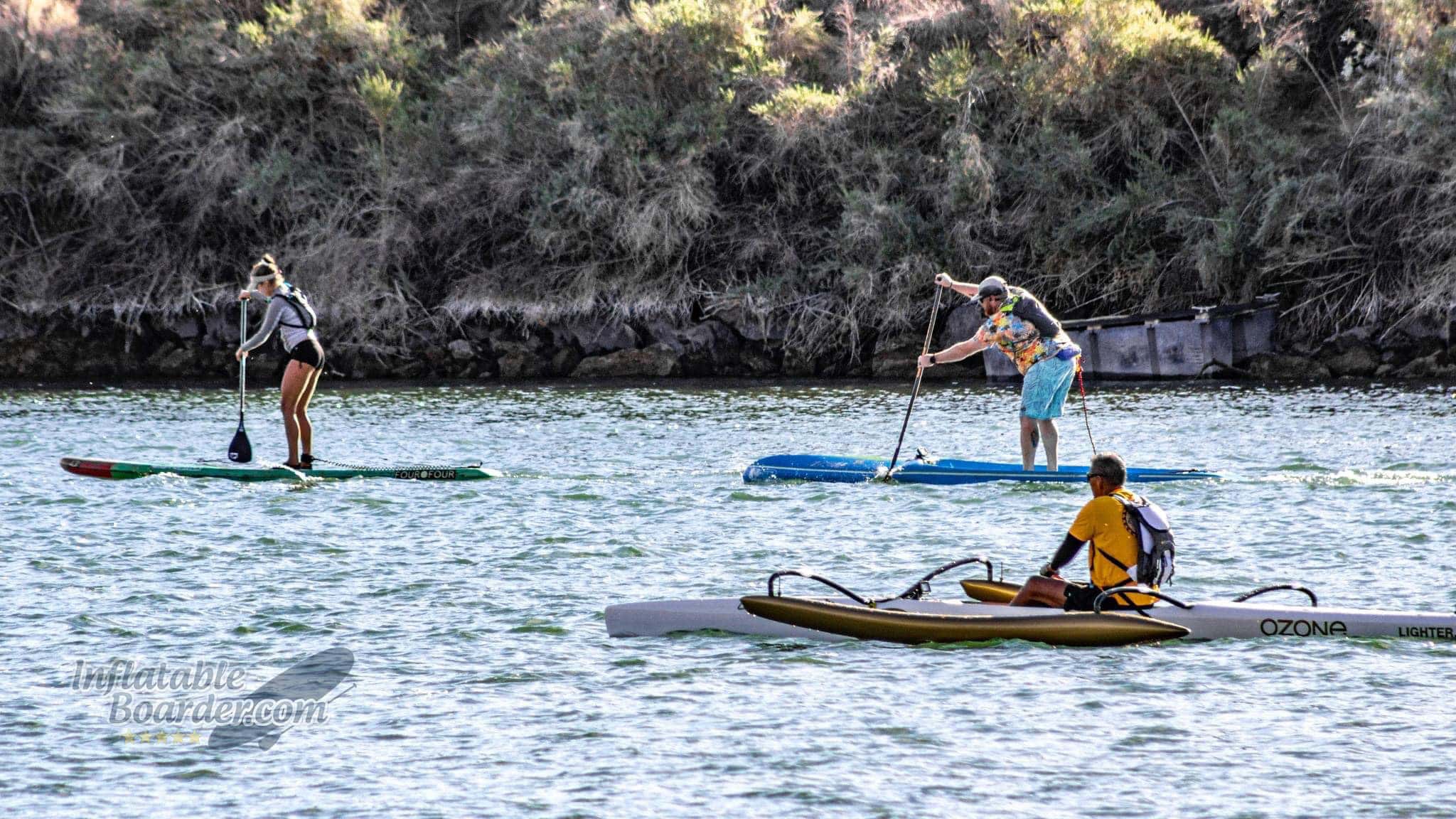
SUP racing at the highest level is all about marginal increases in speed performance. Here a paddler needs to maximize everything. Long, narrow boards for speed; Rigidity for power transfer; specific shapes to handle different conditions. At a high-level, Composite SUPs offer better speed, rigidity, and shaping opportunities than inflatables do.
At lower and mid-level competition, marginal differences in the board make far less of a difference than paddler technique and fitness. Here a high quality racing iSUP is going to compete very well against a racing composite board, particularly in shorter races less than 5 miles. Another thing to consider is transportation. Having a fast composite race board at home doesn’t mean you can always get it to the race destination. Inflatable race boards like the Starboard All Star Airline, Red Paddle Co Elite, and Hydrus Paradise X all provide excellent race performance in a package that can go with you anywhere.
Winner: Hard SUPs
Surfing
SUP Surfing is another performance sport with high demands when done at a high level. Performance surfing with high speeds and tight turns requires a ton of detail to the interaction of the water with the board and fins. To this, hard boards have the ability to take on very complex and nuanced shapes on the hull of the board and along the rails. Both of these areas are critical for performance SUP surfing. Inflatable SUPs are not able to fully mimic these nuanced shapes. Outlines and tail shapes can be generally matched to composite boards, however rail profiles and complexities like concave hulls are not yet fully capable of replication in inflatable boards.
Like racing, SUP surfing can be done at a variety of skill and performance levels. While advanced SUP surfing is best done on a hard board, inflatable SUPs are absolutely at home and comfortable for beginner and intermediate surfing. Boards like the Red Paddle Co Ride 10’6” and Honu Byron are great options for paddle boarders who like to catch the occasional surf session with some control, but also want a board that’s great for all-around use.
Winner: Hard SUPs
Touring and Fitness Paddling
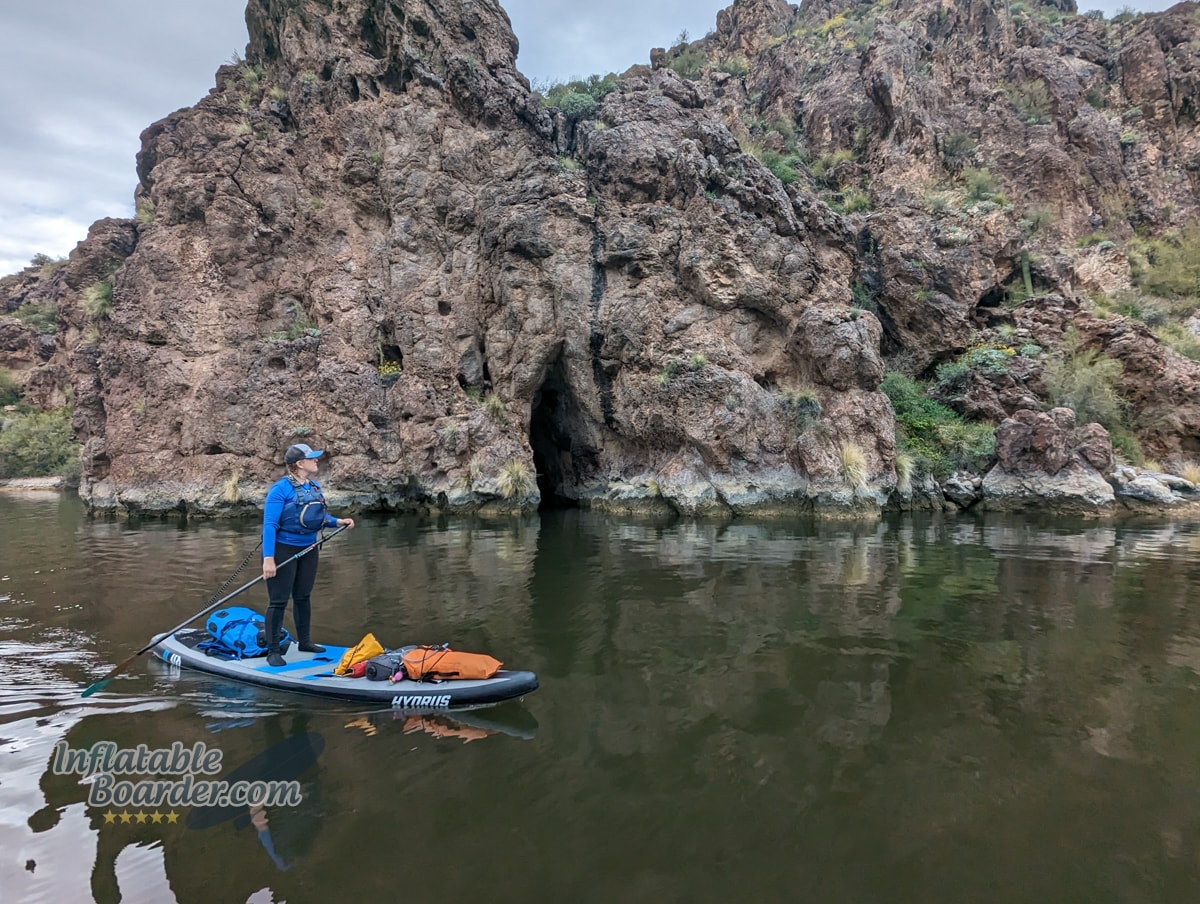
SUP Touring can be considered a hybrid sport with elements of all-around paddling, racing, and backpacking. Whether you’re out for a fitness session, day tour to a nearby destination, or a multi-day trip, touring SUPs all look for Speed through Efficiency, comfortable handling, and some ability to carry cargo at speeds slower than a race.
iSUPs and Composite SUPs are both capable of excellent glide and good handling of choppy conditions and wind. Touring composite boards are frequently 4.5-5.5” thick (and often thicker in the nose) which is similar to 4.7-6” thick iSUPs. How much either board will “catch the wind” in the case of a cross wind will be very similar. As in all cases, your body and the equipment you are carrying will catch more wind than either style of board. Specific boards (both inflatable and composite) may have special shaping elements to help improve handling in these less-than-ideal conditions. Inflatable SUPs are often easier to pack cargo due to their flat decks and typically slightly higher volumes/weight capacities.
Stability between inflatable and composite touring SUPs is quite similar. These longer, narrower (though not as skinny as a race SUP) boards all have lower initial stability than an all-around board and will vary greatly depending on their exact shapes and how they are loaded.
A few great options for inflatable touring/fitness SUPs are the Hydrus Paradise, Honu Sorrento, Sea Gods Carta Marina CX and the Blackfin Model V.
Winner: Tie
Yoga
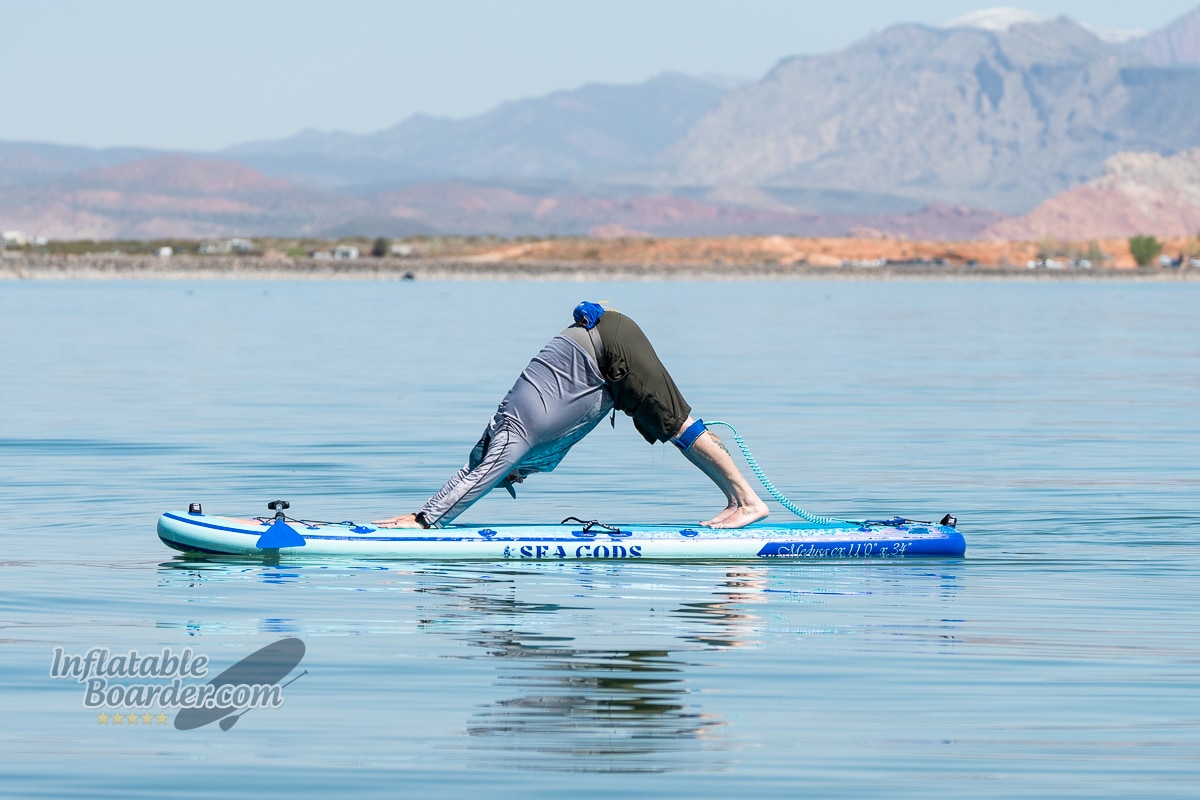
When looking for a Yoga SUP stability and available space are typically the primary factors. Here size and shape are most important followed by rigidity. While that seems to give an edge to hard SUPs, because Yoga involves frequent moving, balancing, and occasional falling, an iSUP provides greater comfort and is less likely to become damaged from an incidental fall or slip. Inflatable SUPs also provide a better margin of safety in case of a slip or fall where you may strike your head as you fall. The current generation of new materials and construction techniques make iSUPs like the Sea Gods Medusa CX, Isle Pioneer Pro 10’6”, and Glide O2 Lotus extremely rigid while still being lighter than other large hard SUPs.
Winner: Inflatable SUPs
Whitewater
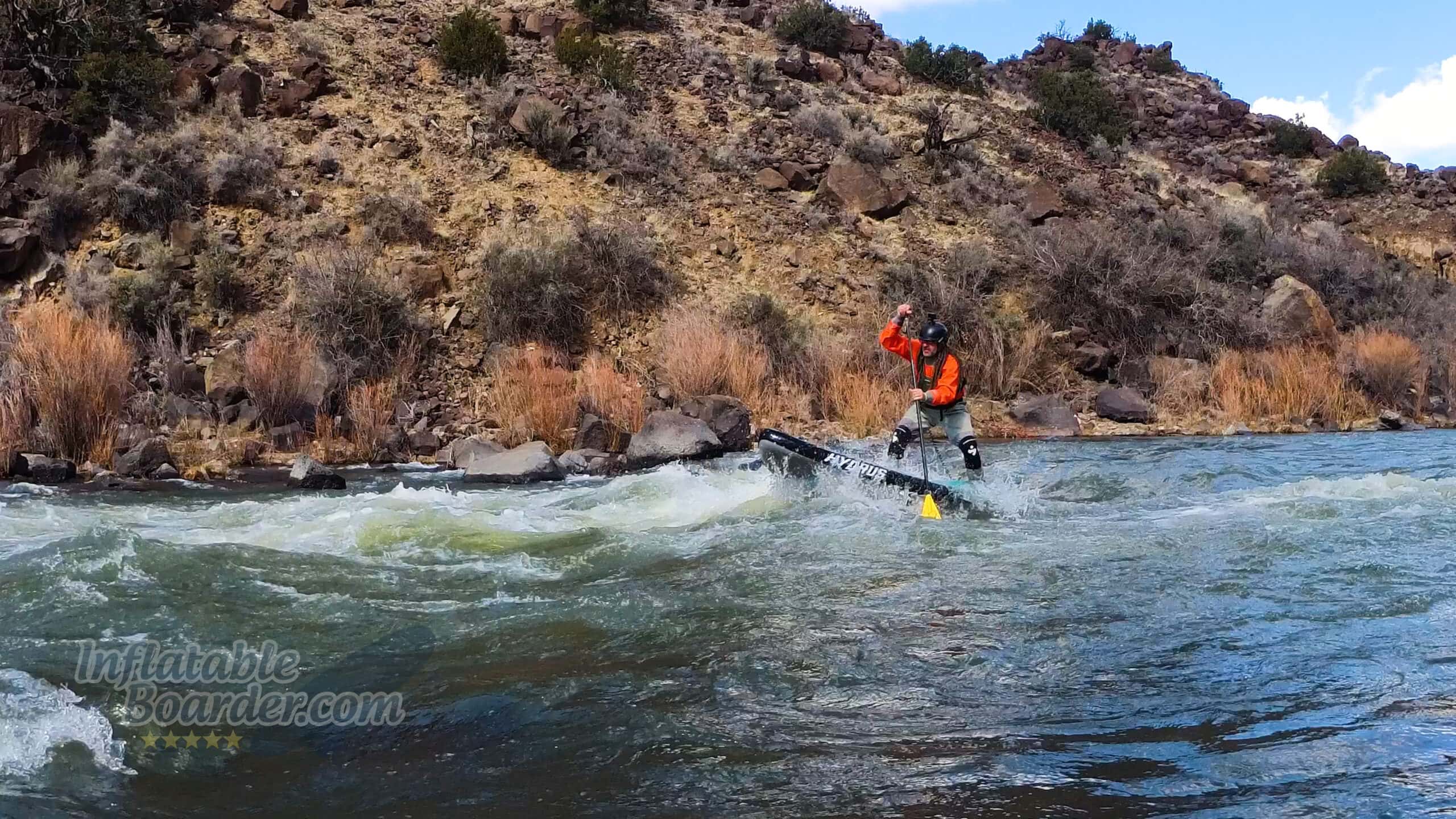
Here we have an obvious winner. Inflatable SUPs are far superior for Whitewater SUP paddling than hard SUPs. Their ability to easily, repeatedly, and without damage bounce off of rocks, logs (and occasionally yourself!) make inflatable boards a much better choice for whitewater paddling. There are some hard boards made specifically for this task as well, but they still can’t handle the rigors that an inflatable can. Rocker profiles, shape, fin selection, and rigidity for whitewater can all be easily accommodated by modern inflatable SUPs at a much lower cost and longer lifespan. For a high performance and affordable Whitewater iSUP, check out the Hydrus Axis 98.
Winner: Inflatable SUPs
Fishing
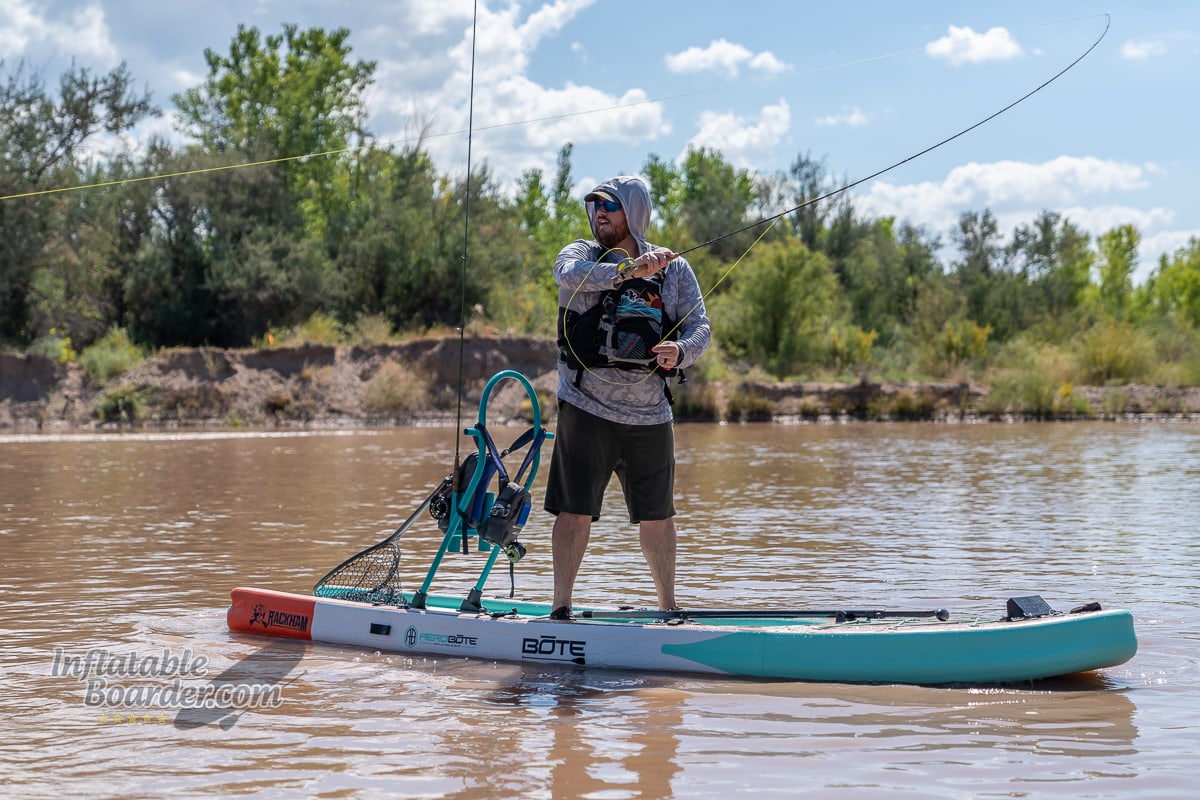
Fishing is another area where inflatables and hard SUPs share more in common with their performance than not. Fishing SUPs are known for their stability, cargo capacity, and ability to mount a variety of different accessories. In terms of paddling performance, these boards all tend to favor wide, stable designs that aren’t known for their speed or handling, but rather give anglers a confident platform from which to practice their craft.
While there are several fishing-specific rigid SUPs available, most offer only additional cargo tie-down points whereas most inflatable fishing SUPs offer a myriad of tie down points, threaded accessory mounts, and fishing-specific mounting points. Because these SUPs are also so large, they often weigh significantly more. Some may worry about punctures from fishing equipment, however most common fish hooks have a gap that is too small to catch on the board itself. Many people frequently and successfully spearfish and crab fish from their inflatable SUPs as well. Both the weight differences and the ease and availability of accessories give the advantage to inflatable SUPs.
Some of our favorite fishing iSUPs are the Blackfin Model XL, Bote Rackham, and Thurso Max.
Winner: Inflatable SUPs
All Around / Cruising
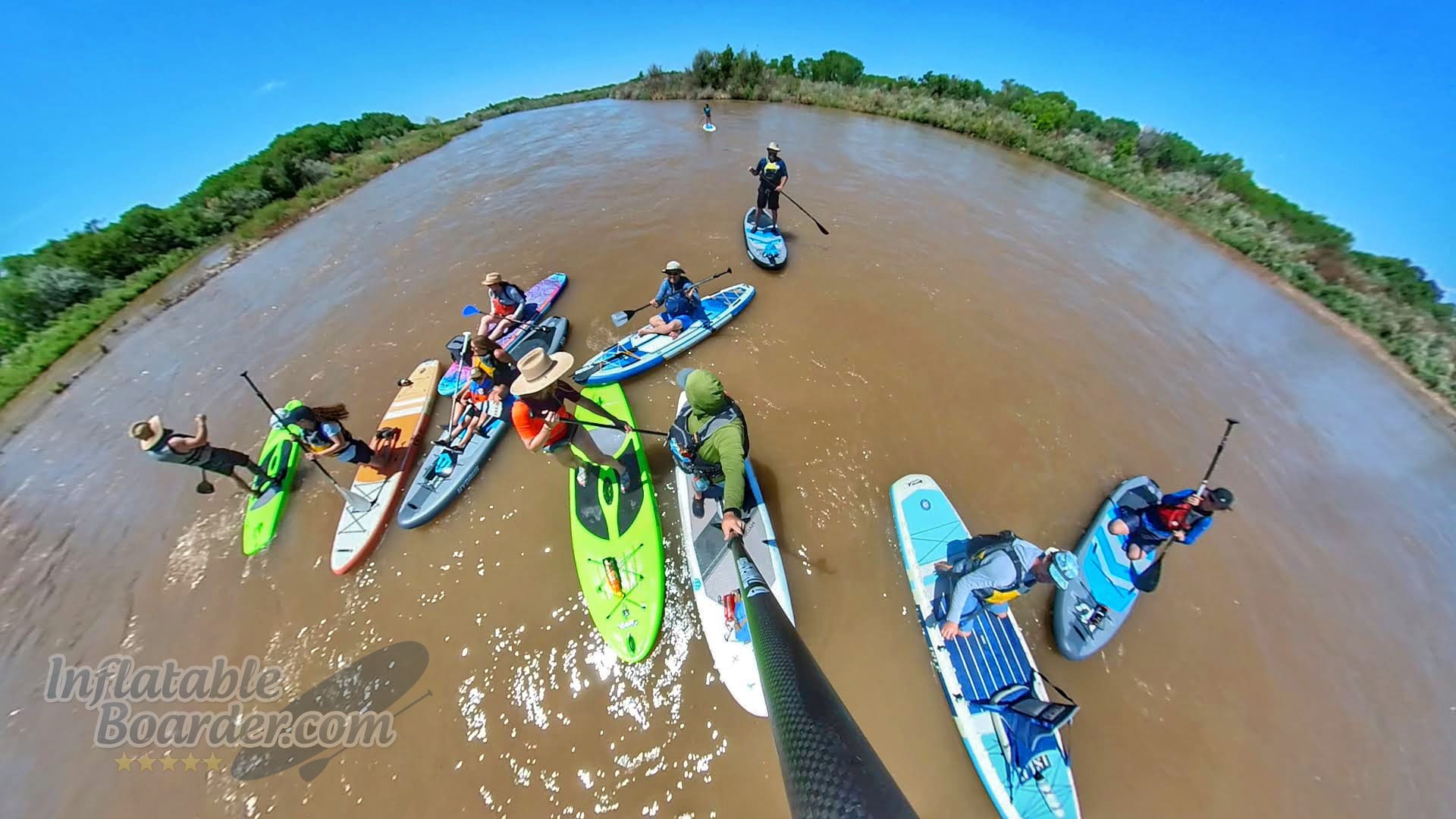
Whether or not an inflatable or hard SUP will be better for general recreational paddling and cruising is going to come down mostly to personal preference. These boards are not designed for performance paddling, but rather to give the user the ability to do a little bit of everything. Here the biggest concerns for paddlers will be ease of use, ease of transportation/storage, approachability, flexibility, and cost. Considering all of these factors I feel there is a “better” choice, and that is an inflatable SUP.
There are so many great options for all-around iSUPs. Check out our list of Best Inflatable SUPs for all-around paddling.
Winner: Inflatable SUPs
Verdict – Which is Better Hard SUPs or Inflatable SUPs?
As I wrote in the beginning of this piece, whether or not an inflatable or hard board is for-sure better will depend on the user and their use of it. Each type of paddle board offers its advantages and disadvantages in different situations. While this is Inflatable Boarder, I do own and use both inflatable SUPs and Hard SUPs. I race on both a composite carbon fiber hard SUP and a high-performance inflatable SUP. I go for casual paddles on fiberglass boards and inflatable boards. I fish from inflatables, I paddle whitewater with inflatables, and I travel with inflatables.
| Inflatable SUPs | Hard SUPs | ||
|---|---|---|---|
| Sizes and Uses | 
| 
|
|
| Transportation/Storage | 
| 
|
|
| Availability | 
| 
|
|
| Durability | 
| 
|
|
| Longevity | 
| 
|
|
| Cost | 
| 
|
|
| Racing | 
| 
|
|
| Surfing | 
| 
|
|
| Touring/Fitness | 
| 
|
|
| Yoga | 
| 
|
|
| Whitewater | 
| 
|
|
| Fishing | 
| 
|
|
| Cruising | 
| 
|
Overall I find inflatable paddle boards to offer more versatility, a more approachable experience, and near-equal performance in all of my paddling, all at a lower price and more compact package. Inflatable boards are also easier to care for and repair (when needed), and require less storage space when not in use. Outside of Racing and Surfing the advantages provided by a hard board basically become moot (or turn into disadvantages).
What do you think? Are hard boards better than inflatables? Inflatables better than hard boards? Let us know why in the comments below!

